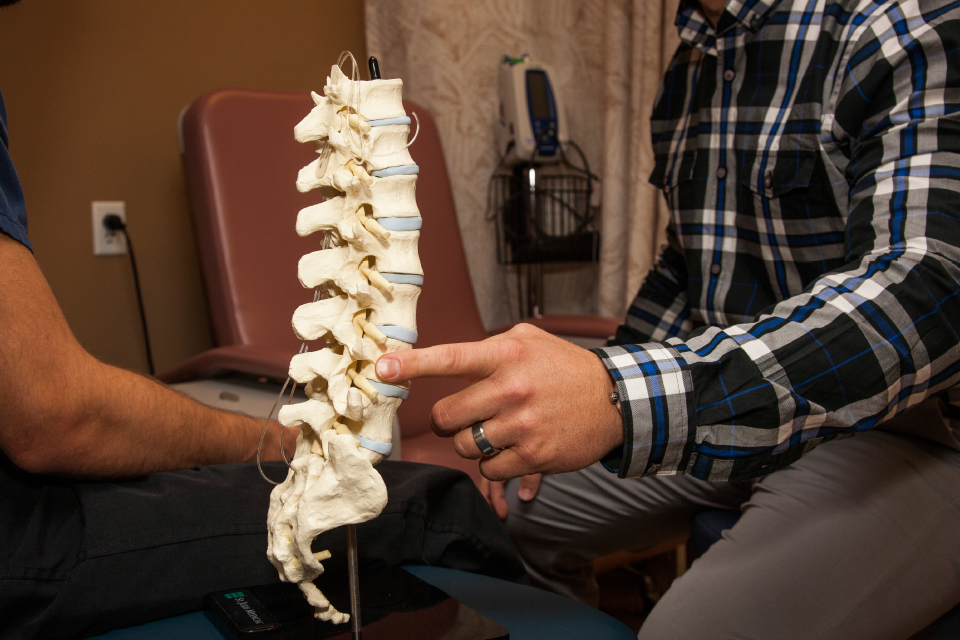What is Pain?

The International Association for the Study of Pain defines pain as “an unpleasant sensory and emotional experience associated with actual or potential tissue damage, or described by the patient in terms of such damage.” Whether pain is caused by actual tissue damage or heightened by emotions, the presence of pain in the body is usually an indication that something is wrong.
Types of Pain: Acute vs. Chronic
In athletics or fitness training, it is common to have acute pain. Acute pain begins suddenly and can feel “sharp” in quality. Possible triggers of acute pain are muscle fatigue, strains, fractures, or disc injuries. This type of pain may last minutes to months in duration and usually disappears when the injury is treated or healed. Chronic pain is pain that persists after an injury to the body has healed and usually lasts longer than six months. Chronic pain complaints might include low back pain, headaches, joint pain, or neuropathic pain (pain from injury to the nervous system). As one might imagine, the emotional toll from chronic pain can be quite profound. What is even more surprising is the magnitude of this problem to the public. According to the 2011 Institute of Medicine report, greater than 100 million Americans suffer from chronic pain. Many of those affected by pain are athletes or involved in fitness training.
Pain’s Role in Fitness and Training
There are many stories of athletic conquests, personal records, and the amount of pain someone can endure to accomplish these tasks. A recent study out of Germany may shed some light on this. Literature from June 2012 issue of the journal Pain suggests that regular physical activity alters the way pain can be perceived. More specifically, those who are regularly physically active and athletes have higher pain tolerances (maximum amount of pain that can be withstood). In general, endurance athletes (i.e. runners) were found to have moderate pain tolerances while athletes involved in game sports (i.e. football) were generally able to tolerate higher levels of pain.
Athletes must be careful to avoid injury themselves. While carrying on through pain is part of many fitness programs, one must be cognizant of any changes or pain that continues longer than expected. It is important to seek help, as prolonged pain can lead to compensatory movement patterns, which can lead to further injury in other areas of the body. For similar reasons, those suffering with chronic pain conditions must be thoughtful of movements, exercises, and other triggers to their condition. As mentioned previously, pain usually serves as an indication that something is wrong in the body and, fortunately, there are many treatment options.
Successfully Managing Pain
Many athletes have treated their own pain with conservative measures such as rest, ice, compression, and elevation of an injury, possibly even over-the-counter anti-inflammatories or acetaminophen. When these measures fail, it is likely time for a professional opinion. Those affected by pain have many therapeutic options to discuss to try to relieve their pain. But what is the best approach?
Pain is usually managed using the care paradigm known as the pain treatment continuum. According to the pain treatment continuum, treatment is initiated with the least invasive modality. If pain doesn’t respond well to one therapy or has become unresponsive to it over time, more aggressive treatment options are used until a therapy or combination of therapies works. Treatment options for patients fall under two main categories: conservative therapies and interventional therapies.
Conservative therapies are predominantly non-invasive treatments and appear on the lower tiers of the pain treatment continuum. Conservative treatments range from exercise programs, physical and psychological therapies, chiropractic care, over-the-counter medications, bracing, transcutaneous electrical stimulation (TENS), and non-opioid based medications. Moderately intensive options—such as nerve block procedures, corticosteroid injections, and opioid medications—are used when appropriate.
If a patient’s pain resists conservative treatments or as patients become refractory to them, interventional procedures may be able to relieve the pain. Interventional therapies include neurostimulation, neuroablation, and surgery. Of the previously mentioned options, neuroablation and surgery are irreversible procedures. Various pain etiologies and each patient’s unique physiology and psychological disposition toward pain are taken into account when a care plan is implemented. Whether the pain is new or has been a problem for many years, there are multiple treatment options available to alleviate pain and continue an active lifestyle.






